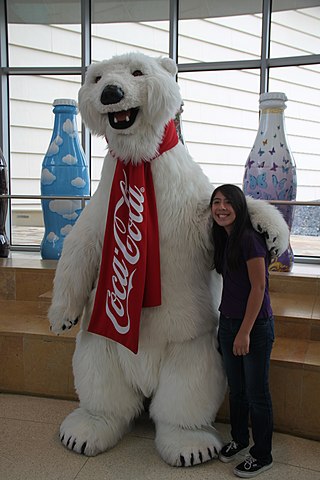
Advertising is the practice and techniques employed to bring attention to a product or service. Advertising aims to put a product or service in the spotlight in hopes of drawing it attention from consumers. It is typically used to promote a specific good or service, but there are wide range of uses, the most common being the commercial advertisement.

Pepsi is a carbonated soft drink manufactured by PepsiCo. Originally created and developed in 1893 by Caleb Bradham and introduced as Brad's Drink, it was renamed as Pepsi-Cola in 1898, and then shortened to Pepsi in 1961. In 2022, it was the second most valuable soft drink brand worldwide, behind Coca-Cola.

Guerrilla marketing is an advertisement strategy in which a company uses surprise and/or unconventional interactions in order to promote a product or service. It is a type of publicity. The term was popularized by Jay Conrad Levinson's 1984 book Guerrilla Marketing.
In marketing, brand management begins with an analysis on how a brand is currently perceived in the market, proceeds to planning how the brand should be perceived if it is to achieve its objectives and continues with ensuring that the brand is perceived as planned and secures its objectives. Developing a good relationship with target markets is essential for brand management. Tangible elements of brand management include the product itself; its look, price, and packaging, etc. The intangible elements are the experiences that the target markets share with the brand, and also the relationships they have with the brand. A brand manager would oversee all aspects of the consumer's brand association as well as relationships with members of the supply chain.
Marketing Communications refers to the use of different marketing channels and tools in combination. Marketing communication channels focus on how businesses communicate a message to its desired market, or the market in general. It is also in charge of the internal communications of the organization. Marketing communication tools include advertising, personal selling, direct marketing, sponsorship, communication, public relations, social media, customer journey and promotion.
In marketing, promotion refers to any type of marketing communication used to inform target audiences of the relative merits of a product, service, brand or issue, most of the time persuasive in nature. It helps marketers to create a distinctive place in customers' mind, it can be either a cognitive or emotional route. The aim of promotion is to increase brand awareness, create interest, generate sales or create brand loyalty. It is one of the basic elements of the market mix, which includes the four Ps, i.e., product, price, place, and promotion.

An advertising campaign is a series of advertisement messages that share a single idea and theme which make up an integrated marketing communication (IMC). An IMC is a platform in which a group of people can group their ideas, beliefs, and concepts into one large media base. Advertising campaigns utilize diverse media channels over a particular time frame and target identified audiences.
In marketing, the promotional mix describes a blend of promotional variables chosen by marketers to help a firm reach its goals. It has been identified as a subset of the marketing mix. It is believed that there is an optimal way of allocating budgets for the different elements within the promotional mix to achieve best marketing results, and the challenge for marketers is to find the right mix of them. Activities identified as elements of the promotional mix vary, but typically include the following:
A target audience is the intended audience or readership of a publication, advertisement, or other message catered specifically to said intended audience. In marketing and advertising, it is a particular group of consumer within the predetermined target market, identified as the targets or recipients for a particular advertisement or message. Businesses that have a wide target market will focus on a specific target audience for certain messages to send, such as The Body Shops Mother's Day advertisements, which were aimed at the children and spouses of women, rather than the whole market which would have included the women themselves. A target audience is formed from the same factors as a target market, but it is more specific, and is susceptible to influence from other factors. An example of this was the marketing of the USDA's food guide, which was intended to appeal to young people between the ages of 2 and 18.

Food marketing brings together the food producer and the consumer through a chain of marketing activities.
The following outline is provided as an overview of and topical guide to marketing:
Brand awareness is the extent to which customers are able to recall or recognize a brand under different conditions. Brand awareness is one of two dimensions from brand knowledge, an associative network memory model. Brand awareness is a key consideration in consumer behavior, advertising management, and brand management. The consumer's ability to recognize or recall a brand is central to purchasing decision-making. Purchasing cannot proceed unless a consumer is first aware of a product category and a brand within that category. Awareness does not necessarily mean that the consumer must be able to recall a specific brand name, but they must be able to recall enough distinguishing features for purchasing to proceed. Creating brand awareness is the main step in advertising a new product or bringing back the older brand in light.
A branding agency is a firm that specializes in creating and launching brands and rebranding. The role of a branding agency is to create, plan, measure, and manage branding strategies for clients, including support in advertising and other forms of promotion.
Marketing buzz or simply buzz—a term used in viral marketing—is the interaction of consumers and users with a product or service which amplifies or alters the original marketing message. This emotion, energy, excitement, or anticipation about a product or service can be positive or negative. Buzz can be generated by intentional marketing activities by the brand owner or it can be the result of an independent event that enters public awareness through social or traditional media such as newspapers. Marketing buzz originally referred to oral communication but in the age of Web 2.0, social media such as Facebook, Twitter, Instagram and YouTube are now the dominant communication channels for marketing buzz.
Street marketing is a form of guerrilla marketing that uses nontraditional or unconventional methods to promote a product or service. Many businesses use fliers, coupons, posters and art displays as a cost-effective alternative to the traditional marketing methods such as television, print and social media. Based on the shifting characteristics of modern-day consumers – such as increased product knowledge and expectations of transparency – the goal of street marketing is to use direct communication to enhance brand recognition.
Brandalism is an activist artist collective founded in 2012 in the United Kingdom which engages in subvertising, culture jamming, and protest art. Brandalism uses subvertising to alter and critique corporate advertising by creating parodies or spoofs to replace ads in public areas. The art is typically intended to draw attention to political and social issues such as consumerism and the environment. Advertisements produced by the Brandalism movement are silk screen printed artworks, and may take the form of a new image, or a satirical alteration to an existing image, icon or logo. The advertisements are often pasted over billboards, or propped under the glass of roadside advertising spaces.

The Lost Island of Alanna is a branded, graphic adventure video game and marketing initiative conceived and directed by Dale Leary and developed with partner Michael Hall of Raintree Media for Coca-Cola Cherry. The game was produced for the brand in the Fall of 1997 and released in the Spring of 1998.
Global advertising or international advertising consists of collecting, processing, analyzing and interpreting information. There are two main purposes of international advertising research: (1) to assist business executives to make profitable international advertising decisions for their specific products and services and (2) to contribute to general knowledge of international advertising that is potentially useful to a variety of business executives, educators, government policy makers, advertising self-regulatory organizations and others interested in understanding the process and effects international advertising.
Rose Creative Strategies, a subsidiary of Rose Marketing Ltd. is an advertising and public relations agency founded in the USSR. The agency originally functioned as a branch of the American agency and offered communication and advertising services to international companies entering the Soviet market.

The Coca-Cola polar bears are fictional polar bears used as mascots by the Coca-Cola Company. The animated characters have been a popular element in Coca-Cola advertising since 1993, and the company sells merchandise such as tumblers and plush bears.






